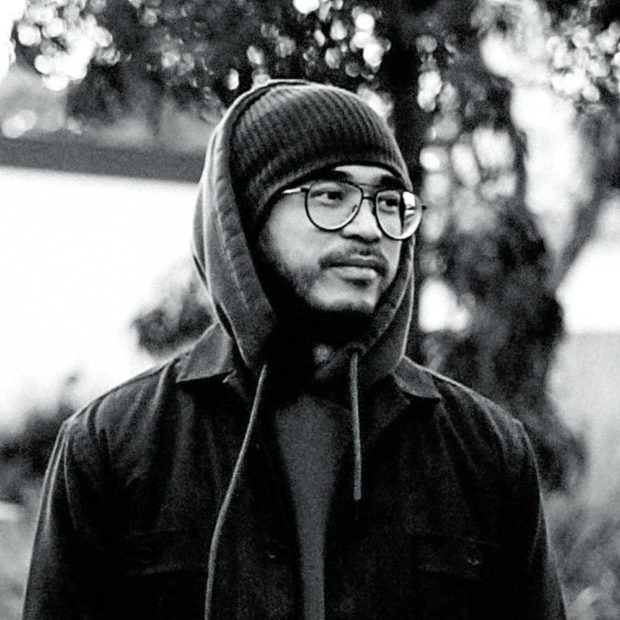
Part visionary art and part surrealism, Mark Inducil makes digital artworks that rise above the mundane world into the realm of the subconscious.
Rendered in motion graphics, an orb symbolic of the Third Eye rotates on top of a woman with a gouged forehead, as she looks at a hand floating in the heavens. In another image, the Melbourne-based digital creative depicts introspection as a man, yet again without a forehead looking at the field while colorful thought clouds swirl above him. Then again, showing equanimity amidst madness, a man closes his eyes, unmindful of whirls that want to overpower him. Digital art has become therapy for Inducil.
Although he majored in engineering in college, Inducil went to Sydney, Australia, in the aughts to study graphic design at Billy Blue College of Design, Torrens University. He came home to the Philippines designing print collaterals and magazine layouts.
In 2004, he returned to Australia to pursue filmmaking. He then worked as a director of photography for music videos and small productions and became a graphic designer with knowledge of motion graphics for a special events company.
A turning point came in 2017, when his father died after a lingering illness. Grief-stricken, Inducil faced “an existential crisis” and read books by such philosophers as Nietzsche and Kierkegaard. He immersed himself in learning new design software and started posting his works on Instagram.
Therapy
“I wanted to rise above my demons. As therapy, digital art making exposed certain issues. I wanted to know myself and the human machine I inhabit and how the psyche works. Thoughts would emerge and I would start working on my art. There were times when I refused to look back even if I needed to confront them. In my first year, I turned to art as self-expression. I envisioned the images and colors as the equivalent of feelings that I was going through,” he recalls.
Images of the figures wrapped in metal and bolts suggested the “human machine.” Skulls surrounded by balls dominated his works. Men in hard hat diving suits were submerged in a bubble environment. Faceless, solitary figures looked pensive in empty space.
Lately, his images have become hauntingly beautiful. Set against a black background, the subjects are suffused with burrowed heads looking upwards, surrounded by clouds and swirls of vivid colors such as magenta, red, purple and blue and bold abstractions. One rare image portrays a man’s defined face looking at a floating cluster of eyeballs. An open palm, symbolic of the hand of blessing, evokes a positive feeling.
“Once I came to terms with myself, I felt more optimistic. In the past, my works were sad with gloomy backgrounds. Now they are brighter as I try to incorporate the outside world. Still, my works are introspective,” says Inducil.
Over time, he started getting more likes on Instagram until he gained nearly 26,000 followers. A follower suggested that he should be selling his digital art in cryptospace or as an NFT (a nonfungible token, the privilege of ownership of a digital file).
Inducil started researching on blockchains (the shared databases that enable cryptocurrencies) and discovered new markets in the metaverse, a universe made possible by augmented reality and virtual reality technology. He underwent a tough screening process to get into MakersPlace, a marketplace for special digital creations and SuperRare. The latter is the digital art market on the blockchain platform Ethereum, which likewise enables artists to apply for their virtual gallery space.
Level up your game
“When we got there, we had to think of ourselves as a brand and market ourselves through Twitter. As in traditional art, you connect with the art community and try to level up your game so that you can attract more collectors and galleries,” says Inducil.
“Being in SuperRare is like being in a computer game wherein your avatar shows the artworks to guests whom you’ve invited through Twitter.”Still young at 42, Inducil says he feels like a “senior” among his collectors, digital natives who are in their 30s. Some buyers want to openly support artists, while others prefer to be anonymous.
“Many collectors have a screen with a nice frame, as in a painting. They plug the USB and appreciate the files. When you buy an NFT, you get a certificate with a signature,” explains Inducil. His works can be as modestly priced as 4,600 ether ($1,981).
Pricing is subjective, as in traditional art. “It depends on how the whales—big collectors—value your work, name recall and branding. You have to show collectors the passion in your works,” he says.
Last year, his Instagram content caught the attention of the prestigious computer software company, Adobe. It commissioned him to test the Aero, the augmented reality software. His posts showed how his digital artworks came alive with animations of a man floating on a pink cloud superimposed over a real cityscape and a face rising triumphantly over psychedelic compositions.
“I felt I had leveled up,” says Inducil.
He was also invited to design the Seven of Spades for the crypto edition of the digital art deck, Playing Arts. He portrayed St. Matthew, the patron saint of accountants, hovering in a surrealist setting in motion graphics.
Inducil describes himself as an introvert, preferring to stay out of the limelight. “The best thing is to keep experimenting with software so you can effectively communicate ideas. I don’t work to seek results because the art would seem forced. It’s more about the journey than the destination.”
—Contributed
Follow @markinducil on Instagram and Twitter; visit markinducil.com